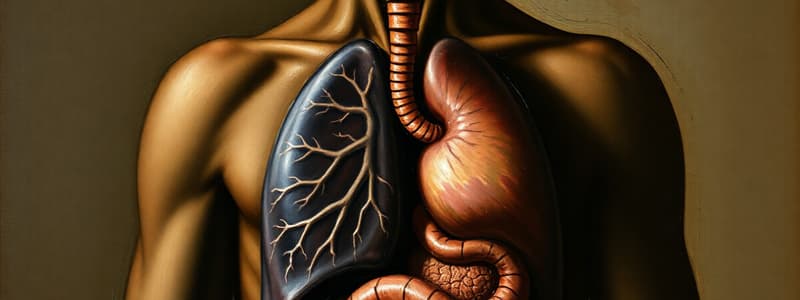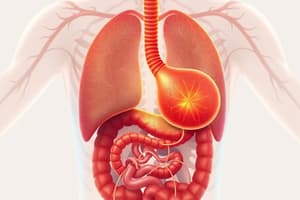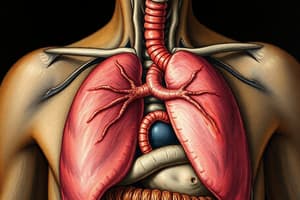Podcast
Questions and Answers
Which of the following structures prevents food from entering the trachea during swallowing?
Which of the following structures prevents food from entering the trachea during swallowing?
- Epiglottis (correct)
- Pharynx
- Larynx
- Trachea
The trachea is lined with cilia, which can help sweep dirt and debris upward towards the pharynx.
The trachea is lined with cilia, which can help sweep dirt and debris upward towards the pharynx.
True (A)
What is the name of the largest piece of cartilage in the larynx?
What is the name of the largest piece of cartilage in the larynx?
Adam's apple
The _____, located at the top of the trachea, contains the vocal cords that vibrate to produce sound.
The _____, located at the top of the trachea, contains the vocal cords that vibrate to produce sound.
What is the primary function of the mucus-secreting cells in the nasal cavity?
What is the primary function of the mucus-secreting cells in the nasal cavity?
Match the following respiratory structures with their descriptions:
Match the following respiratory structures with their descriptions:
The bronchi are smaller than the trachea and branch into bronchioles.
The bronchi are smaller than the trachea and branch into bronchioles.
What is the name of the membrane that separates the chest cavity from the abdominal cavity?
What is the name of the membrane that separates the chest cavity from the abdominal cavity?
The _____ is the largest blood vessel in the body and carries oxygen-rich blood from the heart.
The _____ is the largest blood vessel in the body and carries oxygen-rich blood from the heart.
Which of the following is NOT part of the respiratory system?
Which of the following is NOT part of the respiratory system?
The large intestine is longer than the small intestine.
The large intestine is longer than the small intestine.
What is the function of the gallbladder?
What is the function of the gallbladder?
The large intestine is also known as the __________.
The large intestine is also known as the __________.
Match the following parts of the digestive system with their functions:
Match the following parts of the digestive system with their functions:
Which accessory organ is responsible for producing bile?
Which accessory organ is responsible for producing bile?
The anus is the opening at the end of the digestive tract where waste exits the body.
The anus is the opening at the end of the digestive tract where waste exits the body.
What is the primary hormone produced by the pancreas to regulate blood sugar levels?
What is the primary hormone produced by the pancreas to regulate blood sugar levels?
Type 1 Diabetes occurs when the pancreas secretes more insulin than it should.
Type 1 Diabetes occurs when the pancreas secretes more insulin than it should.
What are the three main components of the circulatory system?
What are the three main components of the circulatory system?
The most abundant cells in the blood are called ______.
The most abundant cells in the blood are called ______.
Match the following components of blood with their primary functions:
Match the following components of blood with their primary functions:
Which of the following is NOT a strategy to avoid diabetes?
Which of the following is NOT a strategy to avoid diabetes?
The lungs are described as the branches of an upright tree.
The lungs are described as the branches of an upright tree.
What is the primary function of platelets in the blood?
What is the primary function of platelets in the blood?
Diabetes is a disease associated with problems in blood ______.
Diabetes is a disease associated with problems in blood ______.
What happens to light when it crosses from one medium to another?
What happens to light when it crosses from one medium to another?
Light always bends toward the normal when transitioning to a medium where it travels faster.
Light always bends toward the normal when transitioning to a medium where it travels faster.
What is the term for the distance from the surface of the water to where an object appears to be underwater?
What is the term for the distance from the surface of the water to where an object appears to be underwater?
A __________ is a phenomenon where a hot road surface appears wet due to bending light.
A __________ is a phenomenon where a hot road surface appears wet due to bending light.
Match the optical phenomenon with its description:
Match the optical phenomenon with its description:
Which of the following best describes a light-emitting diode (LED)?
Which of the following best describes a light-emitting diode (LED)?
A ray diagram uses curved lines to show the light path.
A ray diagram uses curved lines to show the light path.
What is the angle of incidence?
What is the angle of incidence?
A _____ mirror is curved inward like a bowl.
A _____ mirror is curved inward like a bowl.
Which type of reflection occurs off a smooth surface?
Which type of reflection occurs off a smooth surface?
Translucent materials allow light to pass through clearly.
Translucent materials allow light to pass through clearly.
What does the SALT acronym represent in describing images?
What does the SALT acronym represent in describing images?
Match the following terms related to light and mirrors:
Match the following terms related to light and mirrors:
Light that scatters when it passes through is described as _____ material.
Light that scatters when it passes through is described as _____ material.
Which property of a laser distinguishes it from ordinary light sources?
Which property of a laser distinguishes it from ordinary light sources?
Flashcards
Duodenum
Duodenum
The first part of the small intestine, which receives stomach contents and digestive enzymes.
Jejunum
Jejunum
The middle section of the small intestine, where most nutrient absorption takes place.
Ileum
Ileum
The final part of the small intestine, responsible for absorbing vitamin B12 and bile salts.
Cecum
Cecum
Signup and view all the flashcards
Colon
Colon
Signup and view all the flashcards
Gallbladder
Gallbladder
Signup and view all the flashcards
Liver
Liver
Signup and view all the flashcards
What does the pancreas do?
What does the pancreas do?
Signup and view all the flashcards
What is insulin?
What is insulin?
Signup and view all the flashcards
What is glucagon?
What is glucagon?
Signup and view all the flashcards
What is diabetes?
What is diabetes?
Signup and view all the flashcards
What is Type 1 diabetes?
What is Type 1 diabetes?
Signup and view all the flashcards
What is Type 2 diabetes?
What is Type 2 diabetes?
Signup and view all the flashcards
How can you prevent diabetes?
How can you prevent diabetes?
Signup and view all the flashcards
What is the circulatory system?
What is the circulatory system?
Signup and view all the flashcards
What is blood?
What is blood?
Signup and view all the flashcards
Ray Diagram
Ray Diagram
Signup and view all the flashcards
Geometric Optics
Geometric Optics
Signup and view all the flashcards
Incident Light
Incident Light
Signup and view all the flashcards
Transparent
Transparent
Signup and view all the flashcards
Translucent
Translucent
Signup and view all the flashcards
Opaque
Opaque
Signup and view all the flashcards
Mirror
Mirror
Signup and view all the flashcards
Incident Ray
Incident Ray
Signup and view all the flashcards
Normal
Normal
Signup and view all the flashcards
Reflected Ray
Reflected Ray
Signup and view all the flashcards
Refraction
Refraction
Signup and view all the flashcards
Angle of Incidence
Angle of Incidence
Signup and view all the flashcards
Angle of Refraction
Angle of Refraction
Signup and view all the flashcards
Apparent Depth
Apparent Depth
Signup and view all the flashcards
Mirage
Mirage
Signup and view all the flashcards
What are the entry points for air in the respiratory system?
What are the entry points for air in the respiratory system?
Signup and view all the flashcards
What is the role of mucus-secreting cells in the nasal cavity?
What is the role of mucus-secreting cells in the nasal cavity?
Signup and view all the flashcards
What is the role of cilia in the nasal cavity?
What is the role of cilia in the nasal cavity?
Signup and view all the flashcards
What is the pharynx's role in the respiratory system?
What is the pharynx's role in the respiratory system?
Signup and view all the flashcards
What does the epiglottis do during swallowing?
What does the epiglottis do during swallowing?
Signup and view all the flashcards
What is the trachea's function?
What is the trachea's function?
Signup and view all the flashcards
What is the role of cilia and mucus in the trachea?
What is the role of cilia and mucus in the trachea?
Signup and view all the flashcards
How do the bronchi and bronchioles contribute to gas exchange?
How do the bronchi and bronchioles contribute to gas exchange?
Signup and view all the flashcards
What is the diaphragm's role in respiration?
What is the diaphragm's role in respiration?
Signup and view all the flashcards
What is the aorta's function in the respiratory system?
What is the aorta's function in the respiratory system?
Signup and view all the flashcards
Study Notes
Unit 1 - Biology: Atoms
- Physical properties describe a substance without changing its identity, observable or measurable
- Chemical properties show a substance's ability to undergo chemical changes or reactions
- Physical changes alter appearance or form, not chemical composition
- Chemical changes alter chemical composition, creating new substances
Unit 1 - Biology: Atom Structure & Notation
- Electrons orbit the nucleus, negatively charged
- Protons are in the nucleus, positively charged
- Neutrons are in the nucleus, neutral charged
- Atomic Number (Z): Number of protons in an atom's nucleus
- Atomic Mass: Number of protons and neutrons in an atom's nucleus
Unit 1 - Biology: Molecular Compounds
- Polyatomic ions are stable groups of atoms acting like a single ionic particle
- Their charge is shared by all atoms
- Criss-cross method is used for determining ratios
- Brackets must be used
Chapter 2 - Equations: Conservation of Mass
- Matter is neither created nor destroyed
Chapter 2 - Equations: Types of Reactions
- Synthesis: two or more substances combine to form a new substance (2H₂ + O₂ → 2H₂O₂ )
- Decomposition: a compound breaks down to produce two or more substances (CaCO₃ → CaO + CO₂ )
- Single Displacement: one element replaces another in a compound (Zn + CuSO₄ → ZnSO₄ + Cu)
- Double Displacement: ions of two compounds exchange (HCl + NaOH → NaCl + H₂O)
- Combustion: reaction with oxygen to form different products ( C₂H₃ + O₂ → CO₂ + H₂O)
Chapter 3 - Acids & Bases
- Acids are substances that react with metals and carbonates, conduct electricity, and taste sour
- Acids release hydrogen ions (H⁺) when dissolved in water (HCl → H⁺ + Cl⁻).
- Bases are substances that conduct electricity and change the color of acid-base indicators. They feel slippery and taste bitter
- Bases release hydroxide ions (OH⁻) when dissolved in water (NaOH → Na⁺ + OH⁻).
Chapter 3 - Acid Precipitation
- Acid precipitation involves precipitation that becomes acidic
- Result of emissions from industry, such as SO₂ and nitrogen oxides, mixing with moisture in the atmosphere
- Forms acids that fall to the Earth's surface. Example: acid rain with a pH below 5.6
Chapter 3 - Neutralization Reactions
- Neutralization reactions occur when an acid and a base react to form water and a salt.
- For example: HCl + NaOH → H₂O + NaCl
Chapter 1 - Cells: Plant and Animal Cells
- Prokaryotes: cells without a nucleus
- Eukaryotes: cells with a nucleus
Chapter 1 - Cells: Cell Division
- There are three important features of cell division.
Chapter 1 - Cells: Asexual Reproduction
- Offspring are genetically identical
Chapter 1 - Cells: Sexual Reproduction
- Offspring are hybrids of their parents. Involves meiosis to form gametes and fertilization.
- Meiosis produces two cells with half the number of chromosomes (for example, humans: 23 + 23 = 46)
Chapter 1 - Cells: Growth & Repair
- Cells grow by increasing the number of cells.
- Cells divide into smaller cells for efficient functioning.
- Diffusion and osmosis are crucial for cell functions with particles moving from highly concentrated to low concentrations.
Chapter 1 - Cells: Cell Cycle
- Interphase, Prophase, Metaphase, Anaphase, Telophase and Cytokinesis
- Interphase: normal cell functions and DNA duplication occurs
- Prophase: DNA strands compact to form chromosomes.
- Metaphase: Chromosomes line up in the center of the cell.
- Anaphase: Chromosome pairs separate to opposite ends of the cell.
- Telophase: Chromosomes arrive at the poles and cytokinesis begins.
- Cytokinesis: Cell physically divides into two identical cells
Chapter 1 - Cells: Cancer
- Cancer is a group of diseases characterized by uncontrolled cell growth and division
- Benign tumors do not spread
- Malignant tumors can spread (metastasis)
- Types of therapy include radiation therapy, chemotherapy, immunotherapy, surgery and Biophotonics.
Unit 2 - Biology: Animal Structures
- Cells are the basic functional units of life.
- Tissues are groups of similar cells performing a similar function
- Organs are composed of different tissue types
- Organ Systems consist of one or more organs working together to carry out major body functions
- Four main tissue types: epithelial, connective, muscle, and nervous
Unit 2 - Biology: Stem Cells
- Differentiation: cells with exact DNA, have certain genes turned on/off
- Stem cells: unspecialized cells with the ability to become any kind of cell.
- Two forms of stem cells:
- Embryonic: able to differentiate into any type of cell.
- Tissue/Adult: able to differentiate into specific types of different cells
Unit 2 - Biology: Digestive System
- The digestive system is a muscular tube, open at both ends
- Processes digestion via mechanical and chemical means
- Accessory organs include salivary glands, pancreas, liver, and gallbladder
Unit 2 - Biology: Respiratory System
- Includes nasal passages, pharynx, larynx, trachea, bronchi, bronchioles, and alveoli (air sacs).
- Gas exchange occurs in alveoli
- Involves inhalation/exhalation. Oxygen diffuses into the blood, carbon dioxide diffuses out.
Unit 2 - Biology: Circulatory System
- The circulatory system has a pump (heart), a fluid (blood), and vessels (arteries, veins, capillaries) to circulate blood
- Blood components include plasma and cells: red blood cells (carrying oxygen), white blood cells (defense), and platelets (blood clotting).
Unit 2 - Biology: Musculoskeletal System
- The musculoskeletal system is made up of bones, ligaments, cartilage, smooth muscle, skeletal muscle, and cardiac muscle.
- Bones provide support and structure, muscles provide movement.
Unit 2 - Biology: Nervous System
- Divided into the central nervous system and peripheral nervous system
- The central nervous system coordinates incoming and outgoing messages, protecting the brain and spinal cord
- The peripheral nervous system carries messages between the organs and the CNS; includes nerves that control voluntary muscle, senses, and involuntary functions
Unit 2 - Biology: System Interactions
- Systems that work together, including the digestive, circulatory, respiratory, and nervous systems
Unit 3 - Physics: Light
Chapter 1 - Light: What is Light
- Light is an electromagnetic wave with different wavelengths that make up the visible spectrum (400nm - 700nm)
- Light types: include incandescence, luminescence(chemiluminescence, fluorescence, phosphorescence, and triboluminescence) and light emitting diodes (LEDs)
- Ray Model of Light: Light travels in straight lines (rays)
Chapter 2 - Physics: Refraction
- Refraction is the bending of light as it passes through a different medium/substance
- Light speed changes based on the medium, bending it at the border (interface).
- Light can bend toward or away from the normal (perpendicular to the surface) depending if the light speed increases or decreases.
- When something is placed under water, the object may look bent
Chapter 3 - Physics: Lenses
- Lenses are transparent pieces of glass or plastic with at least one curved side
- Converging lenses: make light rays come together
- Diverging lenses: make light rays move apart
- Focal point is the point where parallel light rays meet/appear to diverge (converging/diverging).
Unit 4 - Climate Change: Introduction
- Introductory concepts about climate and classifying climate types
Studying That Suits You
Use AI to generate personalized quizzes and flashcards to suit your learning preferences.
Related Documents
Description
Test your knowledge on the human respiratory and digestive systems with this quiz. Covering key structures, functions, and characteristics, this quiz helps reinforce your understanding of these vital systems. Perfect for students studying human biology!




